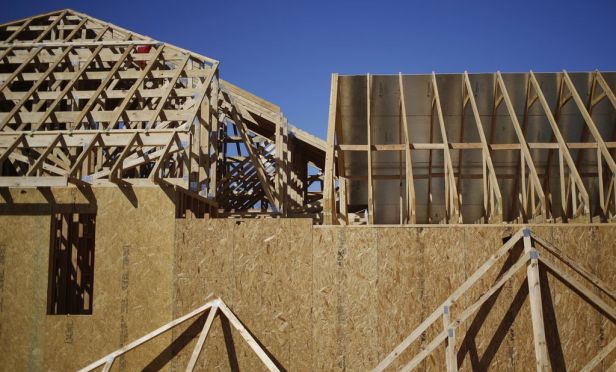 A home under construction stands in the Toll Brothers Inc. Regency at Palisades community in Charlotte, North Carolina. (Photographer: Luke Sharrett/Bloomberg)
A home under construction stands in the Toll Brothers Inc. Regency at Palisades community in Charlotte, North Carolina. (Photographer: Luke Sharrett/Bloomberg)
(Bloomberg) – Five years ago, encouraged by home builders and an anti-regulatory zeal, lawmakers in North Carolina joined other states in weakening building code requirements.
It's a decision they may regret as Hurricane Florence takes aim at the Carolinas.
Recommended For You
New standards for elevating floors aren't in effect
The Legislature in 2013 increased the amount of time between updates to its building code from three years to six. That means that updates that set new standards for elevating the floors in flood-prone homes aren't in effect, according to the Federal Alliance for Safe Homes Inc.(FLASH), a non-profit disaster safety organization.
In 2015, state regulators also eliminated a requirement that storm shutters be permanently anchored.
The Insurance Institute for Business & Home Safety (IBHS) called out North Carolina for the changes in a report issued earlier this year, and lowered the state's score in an assessment of building codes in hurricane-prone states.
"This change means the state residential code will always be one or two cycles behind the latest national model codes," the report said. South Carolina, also under threat from Hurricane Florence, considered similar legislation lengthening the cycle between building code adoption from three years to six, but it did not advance, according to the report.
Shifting cost to consumers
"By not keeping pace you are shifting the cost to the consumer and they don't even know it," Leslie Chapman-Henderson, president of the Tallahassee, Florida-based FLASH said in a phone interview. "If you invest on the front end, it is going to cost a little more but you can avoid the losses all together in most cases."
Recommended codes are issued every three years by the International Code Council, a Washington-based nonprofit that brings together builders, engineers, local code officials and other experts to translate the latest science into updated model building codes. Safety advocates and insurers encourage states to follow those model codes.
Chapman-Henderson said the shift in North Carolina reflected a push from builders, who argue that new codes make houses more expensive, reducing demand.
Teri Edwards, executive officer of the Carteret County Home Builders Association in Morehead City, said the move to decrease the amount of time between code updates came as regulators and permit officers were having trouble keeping pace with code makers' model code updates. Still, she said, cost was also a factor.
'We aren't going to hurt anybody'
"We aren't going to hurt anybody," Edwards said by phone."We want to make sure we aren't changing codes just for the sake of changing codes."
The National Association of Home Builders points out that other states, including Utah, Michigan and Minnesota, have also legislated a six-year cycle.
"The six-year cycle is reasonable in that the codes have matured over the past 20 years, especially as it relates to structural design," the trade group said in an emailed statement.
International Code Council takes sides
Dominic Sims, the chief executive officer of the International Code Council that issues the model codes every three years, disagrees, calling six years an "arbitrary" length of time that "doesn't make much policy sense."
"We are going to make sure the best science is available every three years in the hopes state governments and local jurisdictions make the right decision," Sims said in an interview. "I think the safe thing to say is staying current with building codes is a good practice."
Easing off building codes
The IBHS report found that other storm-prone states have been easing their building codes even as the effects of global warming escalates amid increasing anti-regulatory sentiment among state officials, and the desire to avoid anything that might hurt home sales.
"While no single meteorological, physical, or economic attribute is responsible for the damage caused by these events, evidence shows that strong, well-enforced building codes reduce loss and facilitate recovery," the group said in their report.
North Carolina's 2013 decision means that code requiring at least one foot of elevated space known as "free board" in certain residential homes in flood prone areas won't be in effect. In 2015, the North Carolina Building Code Council deleted a requirement that shutters in areas subject to high winds be permanently installed, according to the Insurance Institute.
Storm surge destruction expected
While many homes were built before the new codes would have taken effect, without them houses rebuilt after the hurricane won't be required to use the most up-to-date codes, said Debra Ballen, general counsel and a senior vice president at the Insurance Institute.
"The expectation is there are going to be a lot of things that go down. A lot will be destroyed by storm surge," Ballen said. "We want to have those homes built to the best possible, most modern codes."
Got photos to share? We'd like to see them. PropertyCasualty360.com readers who have images of Florence's path can send them via e-mail to [email protected], for inclusion in our coverage.
© Touchpoint Markets, All Rights Reserved. Request academic re-use from www.copyright.com. All other uses, submit a request to [email protected]. For more inforrmation visit Asset & Logo Licensing.







